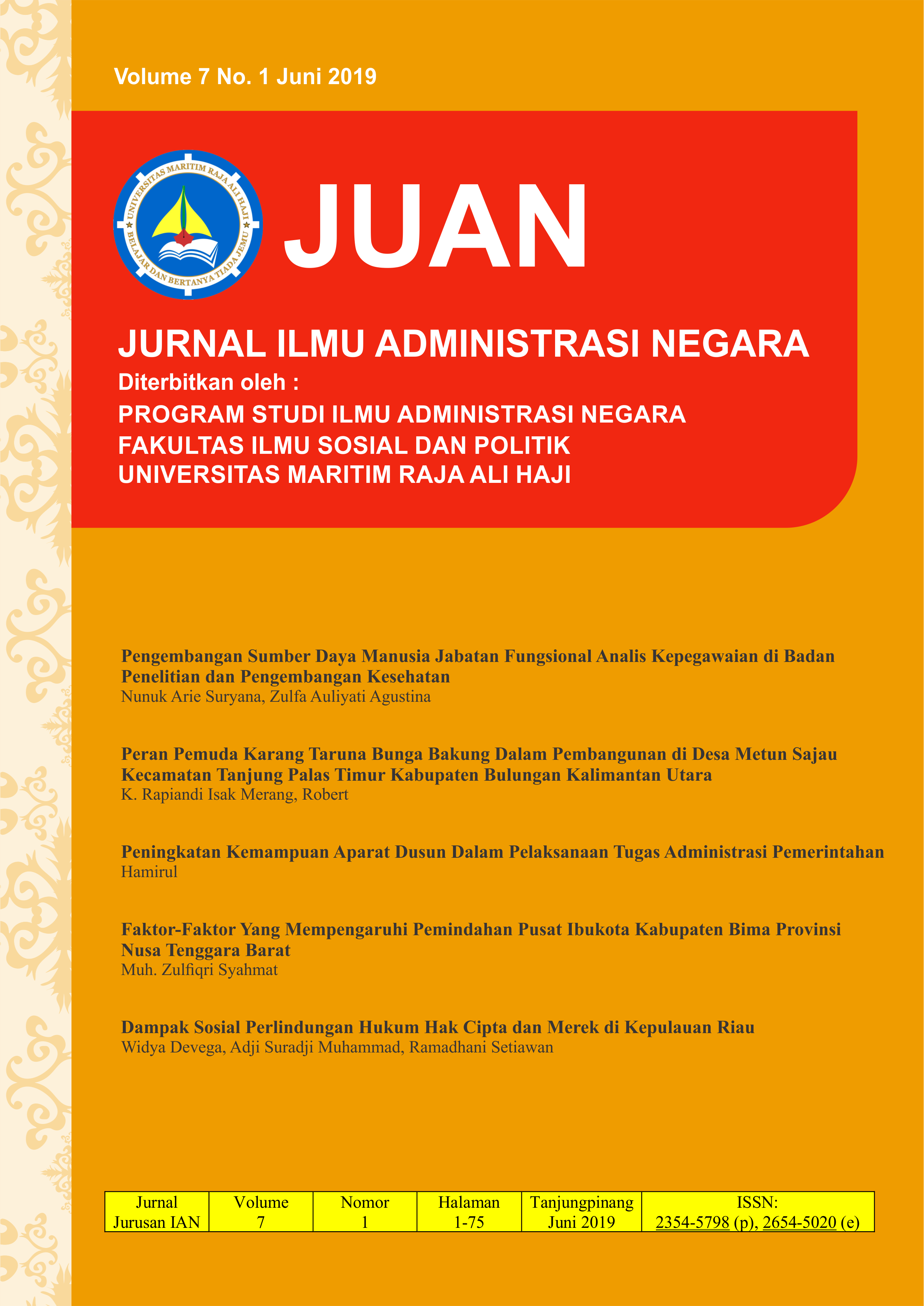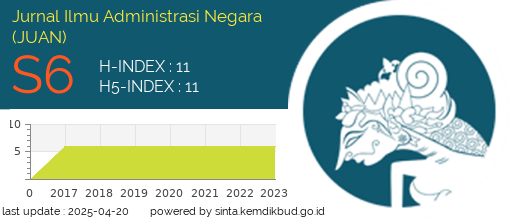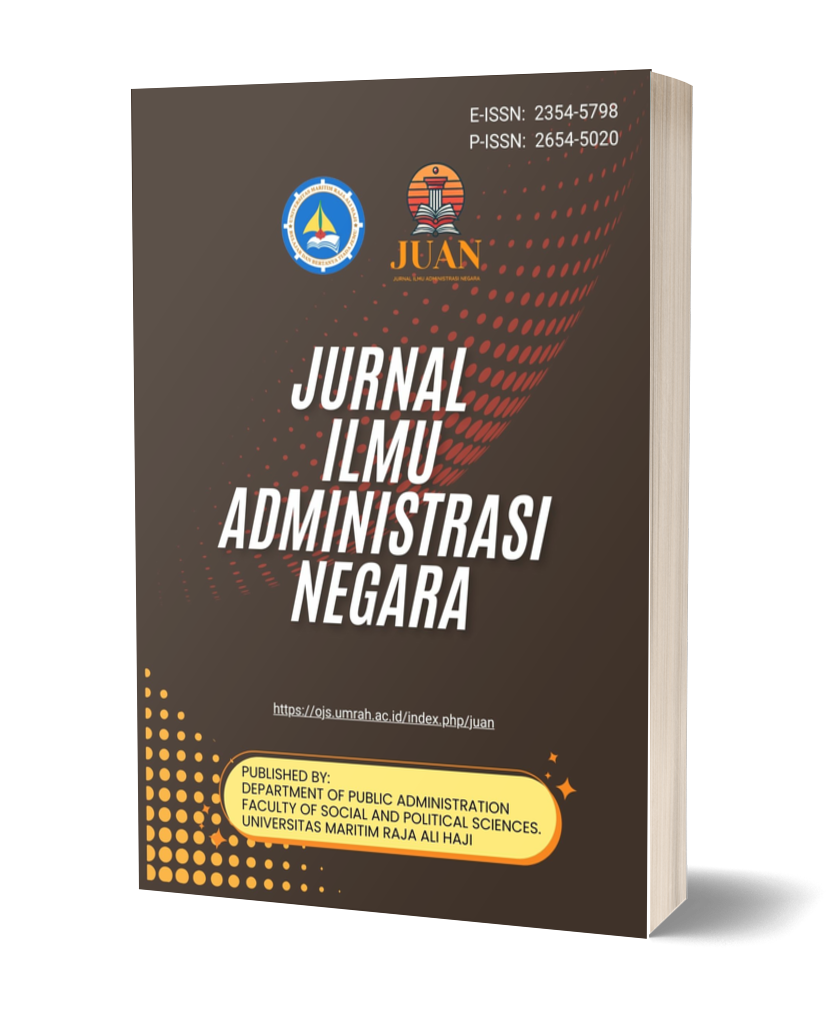Faktor-Faktor Yang Mempengaruhi Pemindahan Pusat Ibukota Kabupaten Bima Provinsi Nusa Tenggara Barat
DOI:
https://doi.org/10.31629/juan.v7i1.1327Abstract
Abstract
Based on the subject matter, the purpose of this study is to know and understand and analyze how the process of transfer of the Capital District of Bima and analyze the factors that affect the transfer of the center of the Capital District of Bima. In this study the researchers took Qualitative research method, where the location in this study was conducted in the Government of Kabupaten Bima, West Nusa Tenggara. Data collection in this study using observation, interview and documentation. Result of research In implementation displacement center of capital and development capital of Regency of Bima in new location is in process of development of infrastructure of 43 Organization of Regional Device only 6 OPD already located at central government service location of Regency of Bima From background of transfer center of capital of regency of bima which background inhibition of transfer of capital center of Bima Regency is budget factor, where fund used in infrastructure development is only sourced from APBD. From the fifth (5) factors that affect the transfer of the capital city of Bima Regency, namely geographical location, population factor, government policy factor, political factor and historical / historical factors have been running well, it means supporting and influencing acceleration of transfer center of Bima regency capital.
Keywords: (Local Government; Factors; Displacement; Capital)
Downloads
References
Ali, M.F.U.2010. Evaluasi Lokasi Pusat Pemerintahan Kabupaten Halmahera Tengah. Tesis.
Ahmad dan Abdul Hamid. 2008 . Lembaga Keuangan Syariah : PT. Bestari Buana Murni.
Claval, P. 2000. The European System of Capital Cities. Geo Jurnal 51 (1/2), 73 -81.
HR, Ridwan. 2014. Hukum Administrasi Negara Edisi Revisi. Jakarta : PT. Raja Grafindo Persada.
Margono, 1997. Metodologi Penelitian Penddikan. Jakarta. Rineka Cipta.
Michigan Lean Consortium. 2013. State of Michigan: Good Government Initiative (internet). http://michiganlean.org/page-1356647 (diakses 27 Oktober 2017)
Myoe, M.A. 2006. The Road to Naypyitaw : Making Sense of The Myanmar Government’s Decision to Move its Capital. Asia Research Institute National University of Singapore 79 (-), 1-19.
Qi, D. 2008. Early Capital Cities- The Key Simbol of Early Chinese Civilization. Front.Hist.China 3 (1), 1 – 11.
Rieseneder,F.B.2008. Good Governance: Characteristics, Methods, and The Austrian examples. Transylvanian Review of Administrative Sciences 24 (E), 26-52.
Rustiadi, dkk. 2009. Perencanaan dan Pengembangan Wilayah . Jakarta: Yayasan Obor Indonesia
Sadjijono, 2008, Memahami Beberapa Bab Pokok Hukum Administrasi,Laksbang Pressindo, Yogjakarta, hal. 41
Siong, H.C. 2006. Putrajaya-Administrative of Malaysia : Planning, Concept, and Implementation. Suistainable Urban Development and Governance Conference SungKyunKwan University Seoul.
S.H. Sarundajang, 2003. Birokrasi Dalam Otonomi Daerah, Upaya Mengatasi Kegagalannya.
Syarif, A. 2013. Faktor-Faktor yang Mempengaruhi Perkembangan Fisik Kota Baubau.Tesis: Universitas Gadjah Mada.
Tarigan, R. 2006. Perencanaan Pembangunan Wilayah . Edisi Revisi. Penerbit: PT. Bumi Aksara.
Tukiyat. 2002. Pengembangan Wilayah dan Otonomi Daerah. Bab 6: Pengantar Pengembangan Ekonomi Wilayah. Jakarta: BPPT.
Wusten, HVD.2000. The Cityscape of European Capital Cities. GeoJurnal 51 (-), 129 – 133.
Peraturan Perundang-undangan :
UU Nomor 13 Tahun 2002 Tentang Pembentukan Kota Bima Di Provinsi Nusa Tenggara Barat
Undang-Undang Republik Indonesia Nomor 23 Tahun 2014 Tentang Pemerintahan Daerah
Peraturan Pemerintah Nomor 129 Tahun 2000 Tentang Persyaratan Pembentukan Dan Kriteria Pemekaran, Penghapusan Dan Penggabungan Daerah
Peraturan Pemerintah Republik Indonesia Nomor 31 Tahun 2008 Tentang Pemindahan Ibu Kota Kabupaten Bima Dari Raba Wilayah Kota Bima Ke Kecamatan Woha Kabupaten Bima
Peraturan Pemerintah No 78 Tahun 2007 Tentang Pembentukan, Penghapusan, Dan Penggabungan Daerah.
Downloads
Published
Issue
Section
License
You are free to:
- Share — copy and redistribute the material in any medium or format for any purpose, even commercially.
- Adapt — remix, transform, and build upon the material for any purpose, even commercially.
- The licensor cannot revoke these freedoms as long as you follow the license terms.
Under the following terms:
- Attribution — You must give appropriate credit, provide a link to the license, and indicate if changes were made . You may do so in any reasonable manner, but not in any way that suggests the licensor endorses you or your use.
- ShareAlike — If you remix, transform, or build upon the material, you must distribute your contributions under the same license as the original.
- No additional restrictions — You may not apply legal terms or technological measures that legally restrict others from doing anything the license permits.













